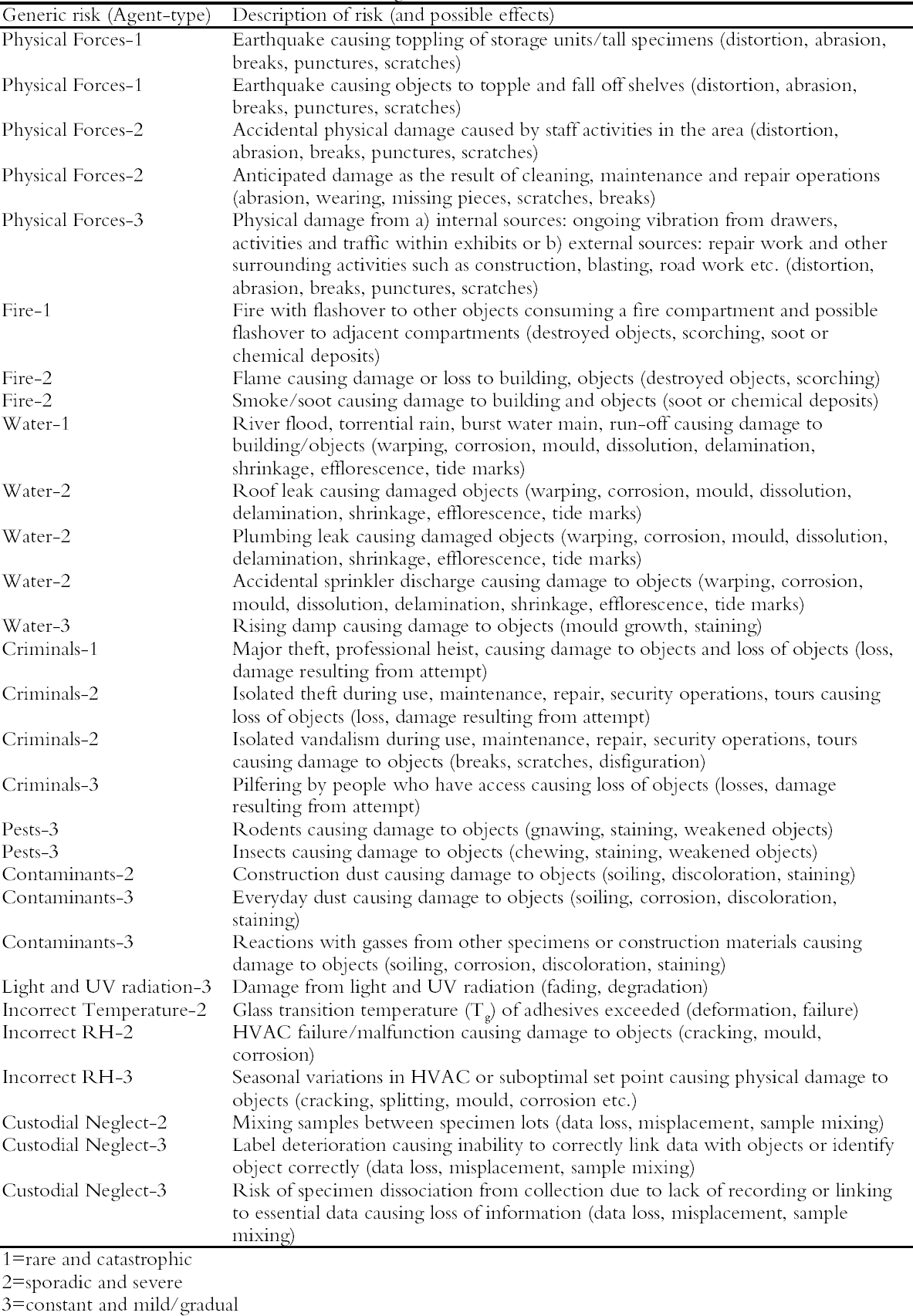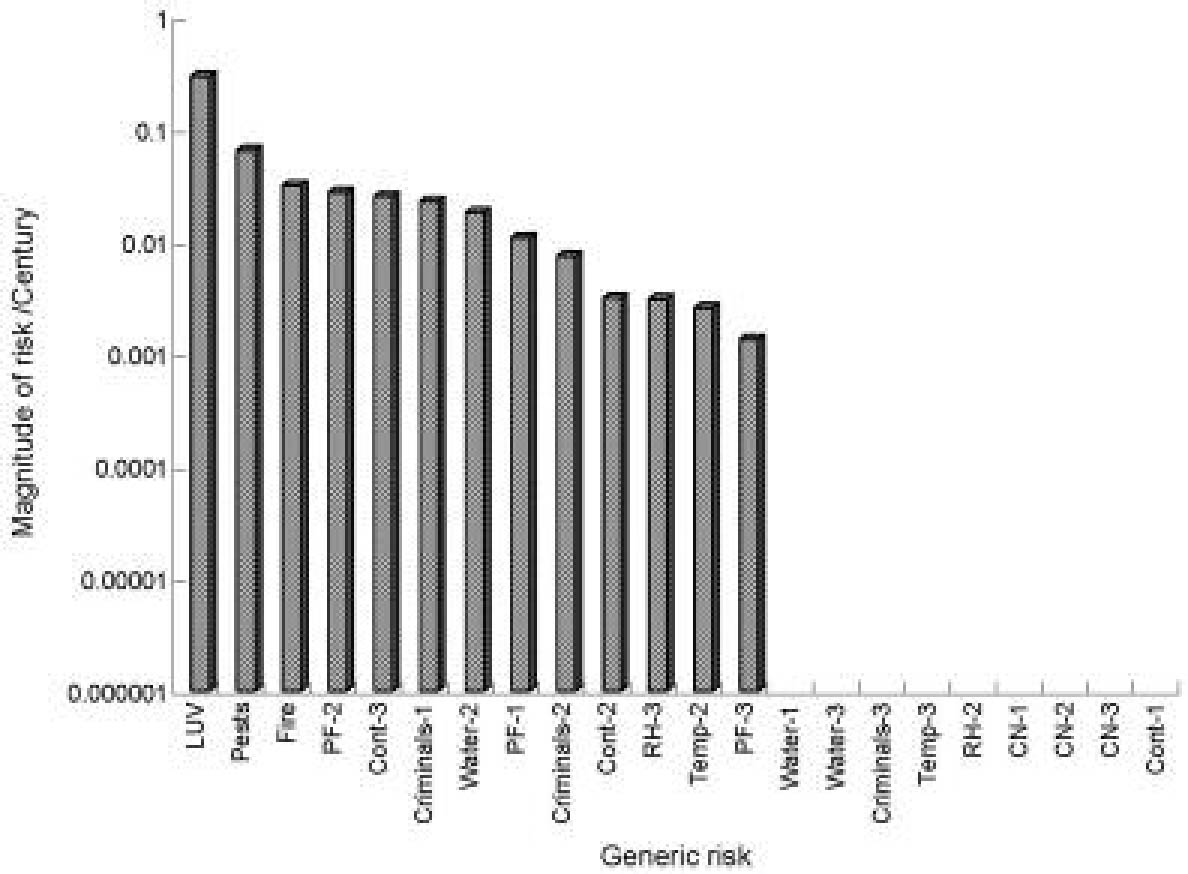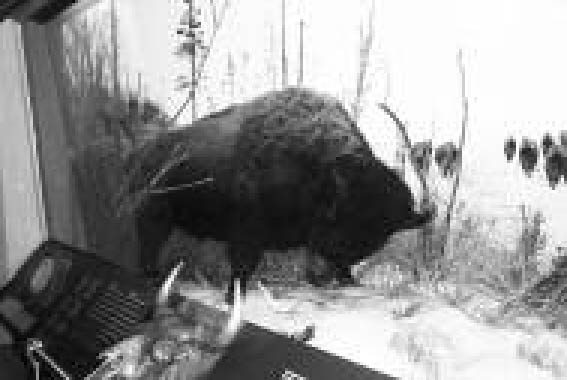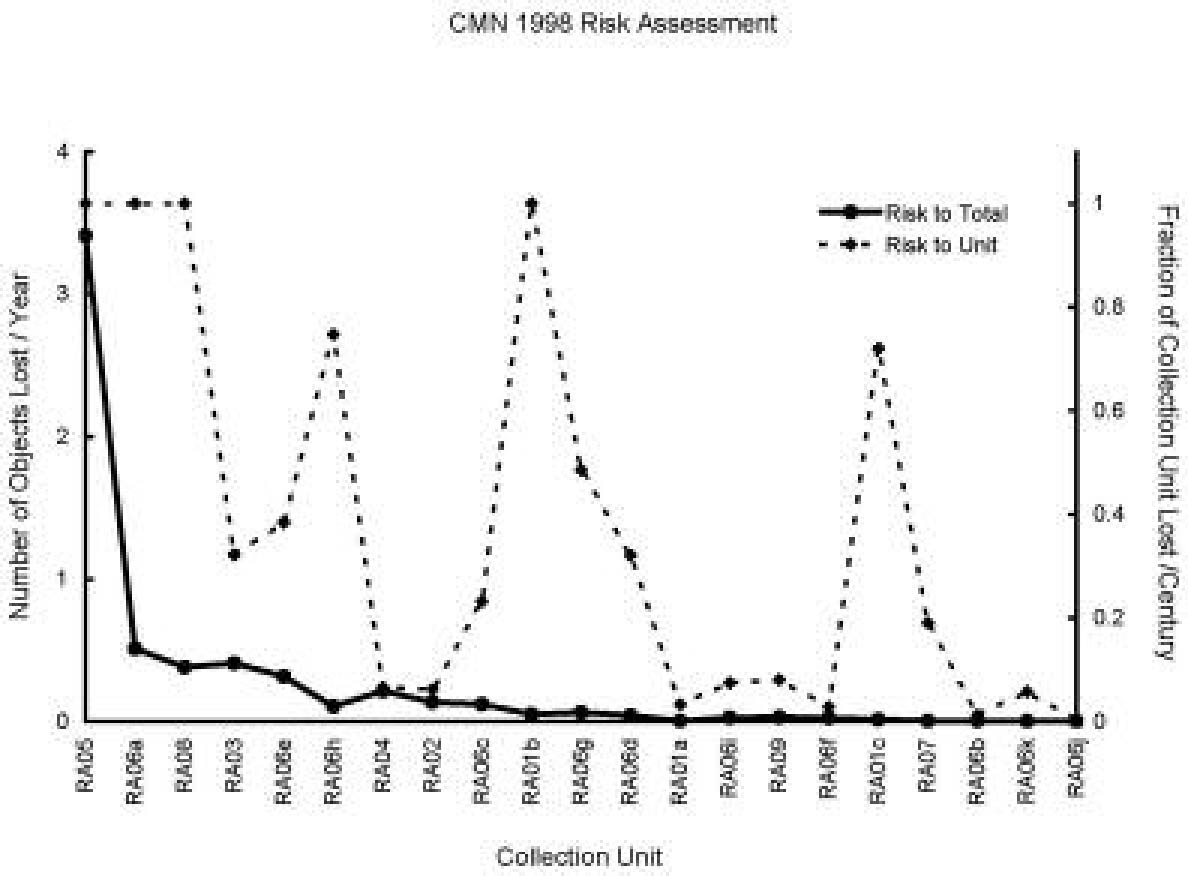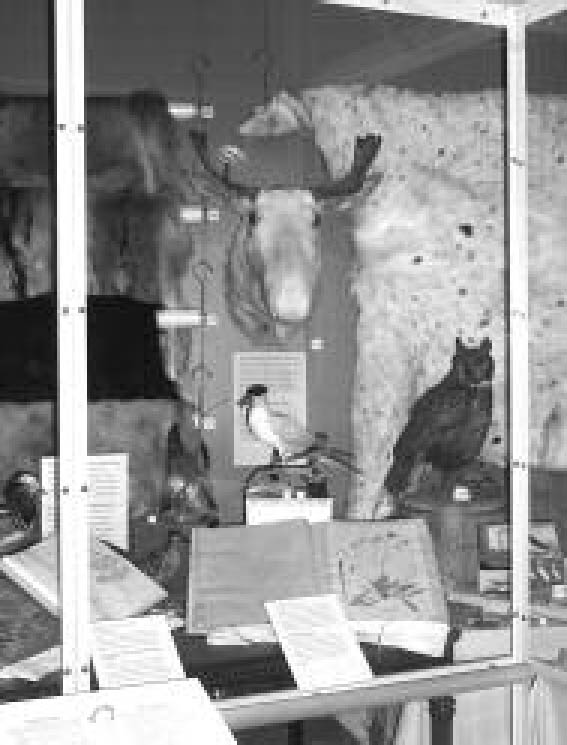RISK ASSESSMENT OF COLLECTIONS IN EXHIBITIONS AT THE CANADIAN MUSEUM OF NATUREGARNET MUETHING, ROBERT WALLER, & FIONA GRAHAM
ABSTRACT—For more than 10 years, the Canadian Museum of Nature has been employing a Risk Assessment approach to preventive conservation, identifying and quantifying the most severe risks to collections, in order to effectively allocate resources for risk management. This paper reports on a risk assessment of collection material at the museum's exhibition facility, the Victoria Memorial Museum Building. The assessment identified priorities to consider during planning for a major renovation project. Specific risks were considered to 21 collection units with a total of 1498 specimens. The seven highest risks are discussed in this paper. These risks are damage or loss from light and UV radiation, pest infestation, fire causing smoke damage, physical forces, dust accumulation, theft and sporadic water leaks. As a result of the assessment, we have a description of the current risk to collections, exhibits, and facilities, and increased awareness and common understanding of preventive conservation issues. The results will help staff make informed decisions in their efforts to provide an improved exhibit environment and extend the exhibit life of specimens. TITRE—�valuation des risques pour les collections en exposition au Canadian Museum of Nature (Mus�e canadien de la nature). R�SUM�—Depuis d�j� plus de dix ans, le Mus�e canadien de la nature a adopt� en conservation pr�ventive une approche d'�valuation des risques en identifiant et en quantifiant les risques les plus s�v�res pour les collections afin d'allouer efficacement les ressources pour la gestion des risques. Cet article pr�sente une �valuation des risques pour les collections qui sont en exposition � l'�difice comm�moratif Victoria, lieu d'exposition du mus�e. Cette �valuation a permis d'identifier des �l�ments � prioriser lors de la planification d'un projet majeur de r�novation. On a tenu compte de risques sp�cifiques pour 21 collections totalisant 1498 sp�cimens. Les sept risques les plus �lev�s sont pr�sent�s dans cet article: il s'agit des dommages ou pertes caus�s par la lumi�re et la radiation ultraviolette, l'infestation d'insectes, la fum�e provoqu�e par un incendie, les forces physiques, l'accumulation de poussi�re, le vol et les d�g�ts d'eau sporadiques. Comme r�sultats, cette �valuation a permis de d�crire les risques actuels pour les collections, les expositions et les installations, et d'accro�tre la sensibilisation et la compr�hension commune des enjeux en conservation pr�ventive. Les r�sultats vont aider le personnel � prendre des d�cisions �clair�es dans leurs efforts pour am�liorer l'environnement des expositions et ainsi maximiser la dur�e d'exposition des sp�cimens. TITULO—Evaluaci�n de riesgos para las colecciones en exhibiciones del Canadian Museum of Nature (Museo canadiense de la naturaleza). RESUMEN: Durante mas de diez a�os el Canadian Museum of Nature ha empleado una estrategia de Evaluaci�n de Riesgos para la conservaci�n preventiva, identificando y cuantificando los riesgos m�s severos para las colecciones, con el fin de destinar recursos efectivamente para la gesti�n de riesgos. El presente art�culo informa sobre la evaluaci�n de riesgos para los materiales de las colecciones en el espacio de exhibici�n del museo, el edificio Victoria Memorial. La evaluaci�n identific� las prioridades a tener en cuenta durante el planeamiento de un gran proyecto de renovaci�n. Se consideraron los riesgos espec�ficos para 21 colecciones, con un total de 1498 especimenes. Los siete riesgos m�s altos se discuten en el presente art�culo. Estos riesgos son los da�os o p�rdidas producidas por la luz o radiaci�n ultravioleta, infestaciones de plagas, incendios que causen da�o por humo, fuerzas f�sicas, acumulaci�n de polvo, robo y filtraciones de agua espor�dicas. Como resultado de esta evaluaci�n, tenemos una descripci�n del riesgo actual para las colecciones, exhibiciones y espacios edilicios, estamos m�s atentos y tenemos un mejor entendimiento de las cuestiones de conservaci�n preventiva. Los resultados ayudaran al personal a estar informado en el momento de tomar decisiones durante sus esfuerzos para mejorar el medioambiente de las exhibiciones y aumentar el tiempo en que los especimenes puedan ser exhibidos. T�TULO—Avalia��o dos riscos das cole��es em exposi��o no Canadian Museum of Nature (Museu Canadense da Natureza). RESUMO—H� mais de 10 anos o Canadian Museum of Nature (Museu Canadense da Natureza) vem empregando a avalia��o de riscos na conserva��o preventiva, identificando e quantificando 1 INTRODUCTIONRisk assessment involves comprehensive identification, quantification, and evaluation of risks to heritage objects and collections (Waller 1994, 1995; Ashley-Smith 1999). The Canadian Museum of Nature (CMN) has been using a risk assessment and management model for preventive conservation planning for more than ten years (Waller 2003). The first risk assessment of collections was completed in 1993. Following the move to a new building of all of CMN's collections, except those on exhibit, an update was performed in 1998 to determine how the new building and storage areas mitigated risks to the collections. These risk assessments provided a formal way to determine which of thousands of potential preservation issues were truly important in terms of risk to our collections. Both the 1993 and 1998 risk assessments were limited to collections held in the systematic (research, reference, and reserve) collections and did not include objects on exhibition. As the vast majority of the collection is not on display at any given time, excluding these objects had a minimal impact on the calculation of the overall collection risk.
However, subsets of the collection on display tend to have higher didactic, aesthetic, historical, and sometimes monetary value than the bulk of the collection, and are exposed to different and often greater risks in the exhibition environment than is the case with the majority of the systematic collections which is not on display. Moreover, there is little rotation of material on exhibit, so risks are continuous and focused on a defined part of the total collection. Consequently, completing a risk assessment of collection material at the Victoria Memorial Museum Building (VMMB) was an important next step in developing CMN's preventive conservation into a risk management process. A further impetus for the VMMB collection risk assessment was the museum's bid for a major renovation project (VMMB Renewal Project). The VMMB is a heritage building built in 1912 (fig. 1). It houses 4 floors of exhibit galleries, ranging in age from 5 to 30 years. The collection at the VMMB includes historic taxidermy mounts, tanned furs, fossils, mineral specimens, skeletons, entomology specimens, herbarium specimens, fluid-preserved specimens, and microscope slides. The building requires renovations for public and collection safety as well as for program delivery reasons. The renovation project will involve the complete dismantling of all exhibits within the museum, building structural reinforcement for seismic purposes, and installation of new heating, ventilating and air conditioning (HVAC), plumbing, and electrical systems. The VMMB collection risk assessment was undertaken to clarify and focus conservation concerns and to provide a record of conditions at the time of the assessment. Specifically, the goals of the VMMB collection risk assessment were to:
2 METHODRisk assessment involved defining the scope of the assessment, identifying all the risks to collections, quantifying those risks to determine their severity in terms of loss to the collection as a whole, and then comparing the risks to arrive at priorities. These priorities informed the planning for projects such as the VMMB Renewal Project. The assessment included all CMN collection material in VMMB exhibits, a total of 1498 specimens. The VMMB currently houses a number of live plants and animals in aquariums and terrariums; for the purposes of the assessment nothing live or borrowed from other institutions was included. The assessment was based on current conditions (i.e., not taking into account renovation plans) in order to identify current risks which could then be addressed during the renovation project. The risk assessment was done using the Cultural Property Risk Analysis Model (CPRAM; Waller 2003). Threats to the collection were identified first by consulting a list of generic risks. Generic risks are based on agents of deterioration (Michalski 1990) combined with a type of risk (Waller 1994). Three types of risk are distinguished by their frequency and severity of occurrence. They are 1-rare and catastrophic, 2-sporadic and severe, and 3-constant and mild/gradual. Generic risks were subdivided into a number of specific risks, in order to achieve a comprehensive list of risks to the collection (table 1). Within exhibits, specimens were grouped into units according to material and taxonomic group (table 2). The 29 specific risks were assessed individually for each of the 21 collection units. Once risks had been identified and collection units had been defined, variables were estimated for each risk. The CPRAM has identified four variables to be used in risk estimation. The variables are fraction susceptible (FS), loss in value (LV), probability (P), andextent (E). Each of these variables is a simple ratio and is between 0 and 1, inclusive. They are explained in general terms below. The fraction susceptible is the fraction of the collection being assessed that is susceptible to the risk being considered. The loss in value is the expected loss in value to the collection as a result of the risk being considered. Probability is the likelihood, based on our best current knowledge, of a type 1 risk event occurring over the next century. Extent applies to type 2 and 3 risks and is the degree of damage or loss to the collection expected to occur over the next century. Each variable had to be determined or estimated for every identified specific risk. In order to arrive at realistic estimates for variables it was necessary to hold interviews and meetings with staff from a number of areas within the museum. Staff from Collections, Research, Facilities, Exhibits, and Security gave information based on their experience with the collections and exhibits at the VMMB. Interviews with staff usually began with a preliminary discussion of the risks being assessed and the identification of the various factors influencing those risks. Once the main factors had been identified, each risk was examined in more detail. For example, for the risk of accidental sprinkler discharge in an exhibit, factors such as the type, number and location of sprinklers in the area, the quantity of water each sprinkler would discharge per minute, the expected response time and emergency response procedures in place, the number and type of specimens in the area, and the type of display cases that specimens are in were all discussed. “What if” scenarios were often used to facilitate these discussions: What is the longest possible time the sprinklers could discharge before response? What is the shortest time? How much value would this type of specimen lose if it were damaged by water? Other information captured during these interviews included monitoring records, exhibit design plans, experiential knowledge, observations, as well as anecdotal information passed on from previous staff. In addition to enabling us to make realistic estimates of risk, this stage of the assessment served to increase awareness of the risks to the collection for all staff involved. To ensure consistency in estimates and avoid subjective judgments, a facilitator collected and reviewed all of the information from staff. The information was then discussed by the Conservation
After all variables were estimated, magnitudes of risk (MR) were calculated for all risks using the equation MR = FS xLV xP xE. Where more than one specific risk was assessed for the same type (for example in table 1, Criminals 2-Theft and Criminals 2-Vandalism) the magnitudes of risk were added to give the generic risk total. The magnitudes of assessed risks were compared to rank the risks by severity. As a result of this ranking seven high-priority risks were identified. 3 RESULTSThe results of the risk assessment can be organized by specific risk (fig. 2) and by collection unit (fig. 3). This type of graphic representation shows the relative severity of certain risks in comparison to others. Presenting information in this manner is useful when discussing results with staff and management and for presenting results to an audience outside of the museum field. Figure 2 shows the magnitudes of risk to the entire collection of objects on exhibit. Note the logarithmic scale required to depict the great range in magnitude of risk. The highest risk (LUV-light and ultraviolet radiation) is four times greater than the next highest (Pests). Nine of the risks assessed resulted in magnitudes of risk too low to register on the chart. Presenting the results in this manner identifies the most significant risks to the collection in terms of loss of specimens.
Figure 3 shows another method for presenting risk assessment results. This representation shows To further illustrate the logic used in estimating risks, the seven highest risks to the collection in order of severity are described in detail below. 3.1 LIGHT AND ULTRAVIOLET RADIATION
The specific risk assessed was the fading and weakening of specimens caused by exposure to light. The factors influencing the severity of the risk are the sensitivity of specimens, the duration and intensity of the light exposure, and the amount of damage that has already occurred versus the rate of future damage. Specimens susceptible to this damage include taxidermy, skins, plants, insect specimens, plant specimens, and fluid-preserved specimens. The sensitivity of a specimen to value loss depends not only on nominal material sensitivity but also on past exposure, (un)evenness of damage distribution, and effect of the pattern of visual changes in objects on the object values. The greatest uncertainty was often in the last factor. Changes in meaning of objects can be significant even for very subtle visual changes. This risk proved to be more than four times greater than the next highest risk. Considering the visible damage to specimens currently on display at the museum, specifically the taxidermy mounts in dioramas (fig. 4), additional damage is certain to 3.2 PESTSThe specific pest risk determined to be most important was insect pest infestation in exhibits resulting in specimen damage such as chewing, bore holes, etc. The factors influencing the severity of the risk are the known presence of insects in the building, past mitigation efforts such as use of pesticides, and previous and reccurring infestations in exhibits. Specimens susceptible to infestation are taxidermy, skins, plants, and insects. The assessment considered the current level of pest monitoring in the building and the subsequent probability of infestations developing in exhibits.
3.3 FIREThe most significant fire-related specific risk was considered to be a small localized fire resulting in soot deposition on specimens. Factors influencing
Areas of particular concern include open exhibits and displays with poorly sealed cases. Some display areas are glazed on the front and sides to provide a barrier between visitors and specimens, but have no tops (fig. 5). In the event of a fire, soot would readily infiltrate these displays and damage specimens. 3.4 PHYSICAL FORCESThe most significant physical forces specific risk relates to accidents that occur during cleaning, maintenance, or repairs, resulting in physical damage to specimens. Factors influencing the magnitude of this risk include ongoing maintenance, open exhibits (as described under section 3.3 Fire), and an annual cleaning project that brings large numbers of people into close proximity or contact with specimens. All types of specimens are susceptible to this risk to some extent. An important potential accident which contributes to this risk is the dropping of light bulbs while they are being replaced within exhibit cases or above exhibits without closed tops. 3.5 DUSTThe specific risk assessed was dust accumulation on specimens. This risk also considered damage occurring when the dust is removed in the course of normal cleaning maintenance. Some risk assessors might argue that this kind of cleaning erosion should be categorized as a physical forces type 3 risk. It was considered a contaminants type 3 risk here since the main controlling factor is dust accumulation. Factors influencing the severity of this risk include open exhibits and poorly sealed display cases. All types of specimens are susceptible to this risk. 3.6 THEFTThis risk includes professional theft as well as pilfering by individuals with access to exhibit areas. The factors influencing the magnitude of the risk are the accessibility of specimens and the constraints on monitoring large and complex exhibit areas. The most susceptible specimens were determined to be relatively accessible items and those in areas that are difficult to monitor, especially attractive and/or valuable specimens (e.g., gems, fossils, and animal skins). Obscured corners and hidden bays in exhibit areas give security guards a limited view of the space and make monitoring of the entire area difficult. 3.7 WATERThis is the risk of water from roof, plumbing, or sprinkler leaks reaching specimens and resulting in staining, mold, and related damage. Factors include an aging plumbing system, an aging roof, and unsheltered sprinkler heads in galleries. It should be noted that the risk of fire, even with sprinklers, is almost double that of water and that the museum is firmly in favor of having sprinklers in the galleries. Nevertheless, it must be acknowledged that sprinklers contribute to the water-type 2 risk. Most specimens are somewhat susceptible to water damage. 3.8 OTHER ISSUES3.8.1 Relative HumidityDespite the lack of relative humidity controls in the VMMB, the risk of relative humidity damage to collections on display proved to be very low. This was not surprising given that the assessment was looking at the risk to existing objects under existing conditions. For the most part, further humidityrelated damage to items that have been on display for many years is minor. When the museum assesses the risk to specimens that will be put on display in the future, the magnitude of risk for certain collections could be high. Achieving suitable levels of relative humidity in the building therefore remains a priority as the museum seeks to exhibit more of its collection material. 3.8.2 DocumentationThe production of the risk assessment highlighted a number of deficiencies in the museum's documentation system. For example, an absence of condition reports and treatment records made it very difficult to assess the degree of damage that specimens had incurred while on display. In many cases only anecdotal evidence was available. A blue whale vertebra that has been on display in the museum for only five years has a large crack in it. Without documentation of the condition of the specimen before it was put on display there is no way of knowing whether the crack predates display or is display-related damage. 4 HOW WE USE THE RESULTS (RISK MANAGEMENT)The quantification and ranking of risks to the collection on display at the VMMB provided strong arguments for including conservation criteria in the plans for a major renovation to the building. This renovation is intended to resolve health and safety issues in the building as well as improve the functionality of the site for contemporary museum operations. One of the project's objectives is to “facilitate the intention of the CMN to make greater use of more collections materials including specimens, artifacts and works of art, at the VMMB, and to increase access to collections for visitors, students, and researchers by providing improved facilities for safe and efficient receiving, handling, storage, display, and programme and research use of collections materials” (VMMBRP 2001, chap. 3:5). Clearly, the renovation will have to address the current risks in order to meet this objective. The CPRAM, like any risk assessment approach (Apostolakis 2004) informs but does not dictate preventive conservation and facility planning processes. Thus, specifications for protective systems, whether security, climate control or other, might be more rigorous than would be dictated by the results of a single risk assessment. As a result of the risk assessment, the case for complete control of artificial and natural light throughout the exhibition spaces was easily made. The need to isolate live plant and animal spaces from the rest of the collection areas seems obvious. Particulate filtration requirements were underlined. Fire protection and security were emphasized. Careful plumbing layout was highlighted. Detailed conservation criteria for these and other elements were provided in the functional program in the early phases of planning. Throughout the design and development phase, a comprehensive understanding of the current risks to the collection informed plans for the renovated building. As construction begins, guidelines for contractors are being developed that reflect the need to manage a number of risks including fire, theft, dust, and physical forces. Conservation expertise is also being integrated into the exhibition development process to mitigate many of the identified risks. All those who are involved in the renovation project are aware of the collection preservation priorities. This was facilitated by presenting the results of the risk assessment to a wide selection of CMN divisions. Conservation staff delivered brief presentations outlining the results and priorities as a means of broadcasting the preservation message. Individuals with different duties were able to see where they could impact the preservation of collections, whether for better or for worse. The response was very positive, with many questions and discussions arising from the presentations. Employees are applying this new awareness and knowledge to their work in various areas of the museum, including the renovation project. The information from the risk assessment has also been worked into other training sessions that the Conservation Section offers to groups of staff and volunteers. 5 CONCLUSIONThis paper has presented an application of the Cultural Property Risk Analysis Model to the collections on exhibit at the VMMB. The risk assessment provided well documented and thoughtful estimates of current risks to collections on display and it guided the decision-making processes for the VMMB Renewal Project. The project involved the quantification of a comprehensive list of risks and resulted in a list of high priorities. The project also identified a number of other issues, such as deficiencies in the current documentation system, and produced a comprehensive documentation of conditions at a specific time. The results of the risk assessment provided the Conservation section with evidence to support arguments for improvements in the exhibit environment and helped to prove the need for continual consultation with the Conservation staff throughout the renovation project as well as during the development of new exhibitions. It also provided a means for Conservation staff to communicate with museum staff in other departments, improving awareness of conservation issues with our museum collection. We are confident that the results of the risk assessment will be the mitigation of many of the current risks to the museum collection on exhibit, an improved environment where we can display more of our collection, and documentation that will allow us to periodically update and reassess the situation in the exhibits and set our priorities accordingly. ACKNOWLEDGEMENTSThe authors are grateful to the many CMN staff who contributed their experience in evaluating risks. REFERENCESApostolakis, G.2004. How useful is quantitative risk assessment?Risk Analysis24(3):515–20. Ashley-Smith, J.1999. Risk assessment for object conservation. Oxford: Butterworth-Heinemann. Harmathy, et al. 1989. A decision logic for trading between fire safety measures. Fire and Materials14:1–10. Michalski, S.1990. An overall framework for preventive conservation and remedial conservation. Preprints of the 9th Triennial Meeting of the International Council of Museums Committee for Conservation. Dresden. 589–591. Victoria Memorial Museum Building Rehabilitation Project. 2001. Functional Programme. Canadian Museum of Nature: Ottawa, Ontario, Canada. Waller, R.1994. Risk management applied to preventive conservation. Preprints of the 15th International Congress. International Institute for Conservation of Historic and Artistic Works. Ottawa. 12–16. Waller, R.1995. Risk management applied to preventive conservation. In Storage of natural history collections: A preventive conservation approach, ed. C. L.Rose, C. A.Hawks, and H. H.Genoways. Society for the Preservation of Natural History Collections. 21–28. Waller, R.2003. G�teborg studies in conservation. Vol. 13, Cultural property risk analysis model: Development and application to preventive conservation at the Canadian Museum of Nature. G�teborg: Acta Universitatis Gothoburgensis: xvi, 189. AUTHOR INFORMATIONGARNET MUETHING has been working as a conservation technician at the Canadian Museum of Nature since October 2001. She obtained a BFA from Concordia University in Montreal, Quebec and a post diploma certificate in Museum Management and Curatorship from Fleming College in Peterborough, Ontario. The focus of her work with the museum has been performing risk assessments both in the Victoria Memorial Museum Building, where exhibits are housed, and the Natural Heritage Building where the majority of the collection is stored. Address: Collection Services Division, Canadian Museum of Nature, P.O. Box 3443, Station D, Ottawa, Ontario, K1P 6P4 ROBERT WALLER is currently the chief of the Conservation Section at the Canadian Museum of Nature. He holds a BSc from the University of Manitoba, a PhD in Conservation from G�teborg University and professional accreditation with the Canadian Association of Professional Conservators. Research interests include: the preservation of mineral specimens and of fluid-preserved collections, and risk analysis approaches to rational decisionmaking FIONA GRAHAM recently left a conservator position at the Canadian Museum of Nature. She has a BA (Hons) in Art History and an MA in Art Conservation from Queen's University in Kingston, Ontario as well as professional accreditation through the Canadian Association of Professional Conservators. Her work at the museum focused on preventive conservation with particular emphasis on the integration of conservation principles into building, exhibition, and storage design and operation. Address as for Muething.
 Section Index Section Index |

